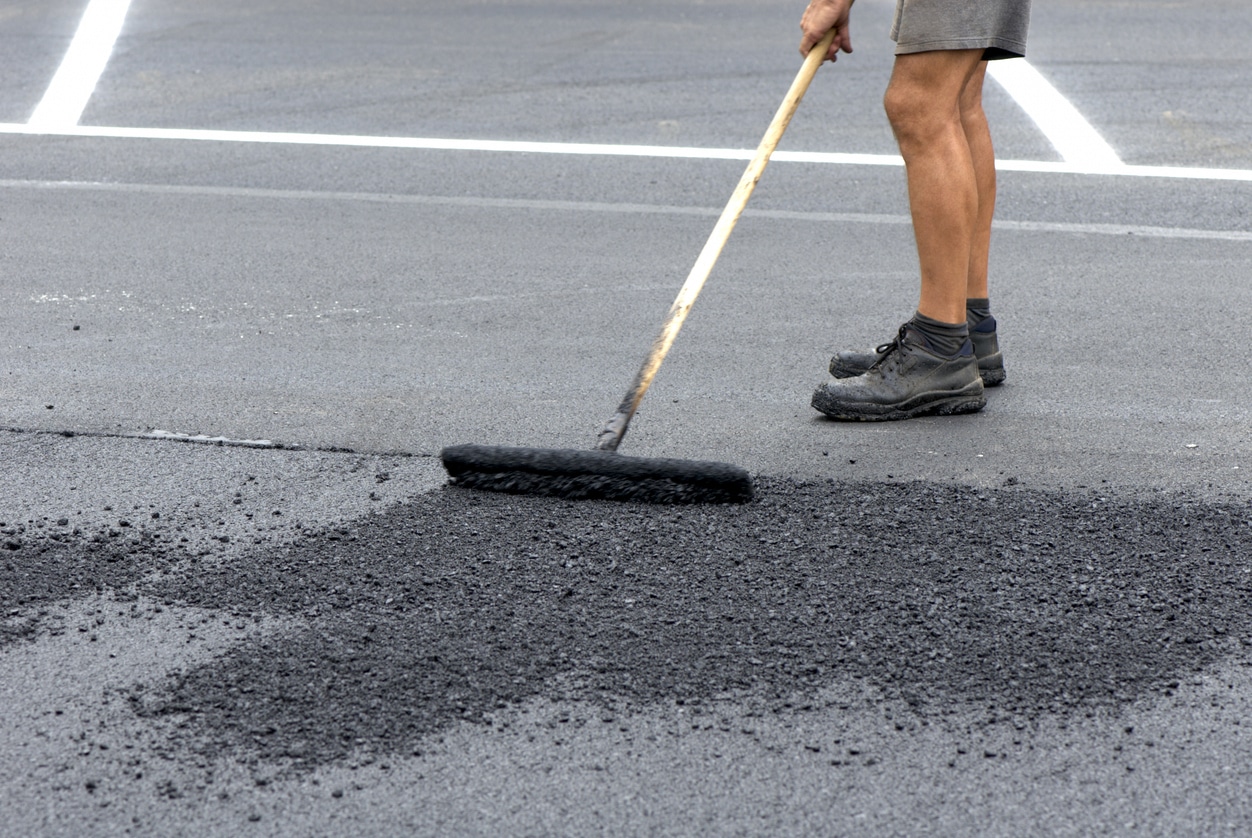If you're undertaking a retail or other commercial construction project, it's important to understand the…

Concrete Solutions for a Sunken Parking Lot
What are the signs of a sunken parking lot? Over time, concrete surfaces settle unevenly. This can cause rounded depressions to form. To prevent potholes and sinkholes, it’s essential to understand what causes these defects and how to fix them.
Customers may avoid your business if they think your parking lot isn’t safe for vehicles or foot traffic. You can’t stop the concrete from settling, but you can take affirmative action, such as vital parking lot paving, to enhance your hardscapes.
What Causes Parking Lots to Sink?
Sunken parking lots have noticeable depressions. You may also notice cracks running toward or away from low spots. In this case, the concrete has settled into depressions in the underlying soil. When these bowl-like shapes collect rain, driving or walking on the lot can be difficult.
Here are some scenarios that may cause concrete to shrink and sink:
- Soil washout: Excessive rainfall, plumbing leaks, and other sources of water can cause the soil beneath concrete slabs to weaken. The concrete surface may sink into empty spaces.
- Soil changes: Soil can shrink, move, and settle due to freezing and thawing cycles and other natural events. Heavy traffic can also compact soil, causing your parking lot to sink. The soil on your land will have unique qualities that will determine the frequency of low spots.
- Poor construction: During construction, workers grade the soil to form a firm foundation before pouring concrete. However, if the soil is not properly compacted, it is more likely to settle significantly. Loose soil is one of the main causes of sunken parking lots. At K&E Flatwork, we take precautions to prevent this.
- Burrowing animals: If moles, groundhogs, and other critters make their homes beneath your parking lot, it can also cause settling and buckling. Rodents are the primary cause of damage due to animals.
- Poor drainage: Ineffective drainage can lead to a negative customer experience and the avoidance of your business. It also presents a slip-and-fall hazard once potential customers step outside their vehicles.
Fortunately, there are many solutions to fixing low spots. Concrete leveling, resurfacing, grinding, and other methods can restore the appearance and functionality of your concrete hardscapes.
Concrete Leveling
There are a variety of methods used to level sunken concrete. Leveling solutions include mudjacking and polyjacking.
During mudjacking, we drill holes into the concrete and pump filler underneath the slab. This is one of the most cost-effective concrete leveling solutions. Typically, it takes longer than polyjacking.
Whereas mudjacking uses sand, water, and aggregate, polyjacking relies on polyurethane foam to lift damaged slabs. Many business owners find this method less invasive than mudjacking. The foam can expand and harden within minutes.
Polyurethane is lightweight and strong, making it a durable solution for fixing sunken concrete. This results in fast, affordable, and uneven parking lot repair.
Resurfacing
If you want to restore the integrity of your entire parking lot, consider resurfacing it with fresh concrete. Our team will start by cleaning the surface to remove dirt, debris, and contaminants. This ensures that the adhesive will stick to the surface, facilitating the addition of a new layer.
Before we begin parking lot resurfacing, we fill in cracks and holes that can compromise the new layer. To do this, we use a proven concrete patching compound that leaves behind a smooth surface.
Adding a fresh layer is one of the most common approaches to concrete repair for sunken areas. This commercial parking lot repair option restores the surface and gives it a fresh appearance. Feel free to reach out with any questions about how to fix a sunken parking lot.
Grinding
In some cases, grinding down uneven sections makes sense. If the depressions in your parking lot aren’t too deep, you can save money by grinding the surface to restore an even grade. This is an excellent solution if you want to fix a small area.
Grind down the uneven sections to eliminate trip hazards: This method uses a concrete grinder to smooth out raised sections. It’s suitable for small areas with minor sinking and can provide a temporary fix to reduce hazards. However, it’s essential to address the underlying cause of the sinking to prevent future issues.
Catch Basin Replacement or Restoration
Catch basins ensure water flows away from your parking lot and the soil supporting it. Adding new catch basins or replacing damaged ones can help avoid parking lot drainage issues. To learn more, refer to our blog on the importance of parking lot drainage.
Sometimes, repairing your existing catch basins is more cost-effective. Consider this part of your parking lot maintenance and include it in your budget for parking lot sinking prevention.
Pervious Concrete
Pervious concrete provides a workable solution for parking lot foundation issues. This material allows water to pass through the lot’s surface, providing a simple solution to managing stormwater. It can help prevent water from accumulating on the surface without weakening the soil beneath it.
K&E Flatwork — Your Source for Sunken Parking Lot Solutions
Investing in parking lot maintenance can enhance the value of your business. It can help keep employees and customers safe and promote a positive business image. If you’re looking for a reliable contractor to help you build or maintain your commercial parking lot drainage issues, K&E Flatwork can help.
Don’t let poor drainage and wear and tear create sinkholes in your lot. Instead, reach out to K&E Flatwork today to find out what factors affect the strength of your concrete surfaces.



